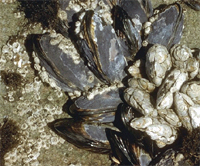Life in a pool by the sea
Tidepools
Tidepools
 Digital observation at the Ocean Institute
Digital observation at the Ocean InstitutePhoto from the Ocean Institute
All that you can do at OI
 Giant Green Anemone
Giant Green AnemoneAnthopleura xanthogrammica
Photo courtesy
Gerald and Buff Corsi
© California Academy of Sciences
 Mussels and gooseneck barnacles and other species.
Mussels and gooseneck barnacles and other species.Photo courtesy Sherry Ballard
© California Academy of Sciences
The rocky intertidal zone is the part of the shore where the tides come-and-go over rocks that peek out at the coast.
It may look like a still-life painting at low tide--when nothing seems to be moving, but plant and animal inhabitants interact and affect each other in many ways. There is keen competition for space, light and food. There is predation--one animal eating another. There are animals living on other animals and even inside other animals!
Life in the tidepools also interacts with its environment. Some animals can only survive where the waves pound the rocks, others need the relative shelter of deeper water. Plants and animals can dry out if exposed for too long at low tide. Some animals cut holes in the rock for themselves to sit in, leaving behind habitats for other animals. Eveyone who's there has managed to find a way to stay alive.
Whether amongst living things or with their environments, many interactions are so slow that we can't see them happening, even when it takes place right before our very eyes--unless we have the right tools for the job.
At the Ocean Institute
Students and visitors at the Ocean Institute can use three different digital video tools to discover the less-than-obvious interactions that take place in rocky intertidal environments. These techniques include:
- Time-Lapse photography - To speed up observation of slow processes
- Counting using photoquadrats - To make an estimate when there are too many to count one-by-one
- Infrared imaging - To see in the dark
Where to find more information:
California Tidepools
All about tidepools with great photos.
Genevieve (Genny) Anderson, Biological Sciences Department, Santa Barbara City College
Printable Field Guides and More
Information about tide pool organisms and more.
Ocean Institute
Southern California's Rocky Shorelines Provide a Habitat for Curiosity
Places around southern California where you can visit a tidepool.
fromWestways, Automobile Club of Southern California
Tide and Water Levels
Learn more about tides. Here "you will find three sections devoted to learning about tides and water levels: an online tutorial, an educational roadmap to resources, and formal lesson plans."
National Ocean Service, NOAA
Tide Predictions at the Scripps Institution of Oceanography Pier
Looking to see when it might be a good time to visit local tide pools? Look at a tide chart to pick the best time and date.
Scripps Institution of Oceanography Library
Water Level Tidal Predictions
Looking for tide tables for other areas around the U.S.?
National Ocean Service, NOAA
State's Tide Pools in Trouble
Make sure to be very careful when you visit the tidepools so that you don't love them to death! Also, remember that collecting is prohibited in many areas and may require a state fishing license.
by Tom Knudson and Nancy Vogel; sacBee, the Online Version of the Sacramento Bee
Frequently Asked Questions About 2004 Sport Fishing Licenses
More information if you want to collect - "Any person who is 16 years of age or older must possess a sport fishing license when taking any fish, shellfish, reptile, or amphibian in California. (Fish and Game Code, Section 7145)."
California Department of Fish and Game
Ed Ricketts and the 'Dream' of Cannery Row
A little about the life of marine biologist Ed Ricketts. Ricketts is perhaps best known for his book Between Pacific Tides about intertidal life. It had been updated many times by others, but the book is still a very useful reference.
National Public Radio
Produced in collaboration with Scripps Institution of Oceanography.
Website by Earthguide.
© 2003-2004 by the Ocean Institute
and the Regents of the University of California.
All rights reserved.
Last modifed Monday, December 10, 2004
